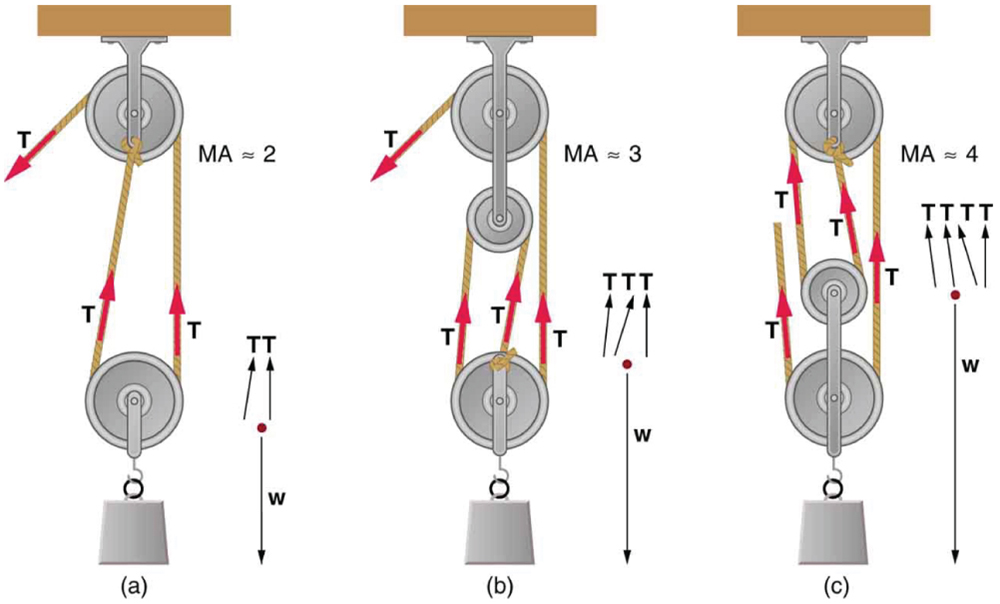| << Chapter < Page | Chapter >> Page > |
An ordinary pulley has an MA of 1; it only changes the direction of the force and not its magnitude. Combinations of pulleys, such as those illustrated in [link] , are used to multiply force. If the pulleys are friction-free, then the force output is approximately an integral multiple of the tension in the cable. The number of cables pulling directly upward on the system of interest, as illustrated in the figures given below, is approximately the MA of the pulley system. Since each attachment applies an external force in approximately the same direction as the others, they add, producing a total force that is nearly an integral multiple of the input force .

Scissors are like a double-lever system. Which of the simple machines in [link] and [link] is most analogous to scissors?
Suppose you pull a nail at a constant rate using a nail puller as shown in [link] . Is the nail puller in equilibrium? What if you pull the nail with some acceleration – is the nail puller in equilibrium then? In which case is the force applied to the nail puller larger and why?
Why are the forces exerted on the outside world by the limbs of our bodies usually much smaller than the forces exerted by muscles inside the body?
Explain why the forces in our joints are several times larger than the forces we exert on the outside world with our limbs. Can these forces be even greater than muscle forces (see previous Question)?
What is the mechanical advantage of a nail puller—similar to the one shown in [link] —where you exert a force from the pivot and the nail is on the other side? What minimum force must you exert to apply a force of to the nail?
25
50 N
Suppose you needed to raise a 250-kg mower a distance of 6.0 cm above the ground to change a tire. If you had a 2.0-m long lever, where would you place the fulcrum if your force was limited to 300 N?
a) What is the mechanical advantage of a wheelbarrow, such as the one in [link] , if the center of gravity of the wheelbarrow and its load has a perpendicular lever arm of 5.50 cm, while the hands have a perpendicular lever arm of 1.02 m? (b) What upward force should you exert to support the wheelbarrow and its load if their combined mass is 55.0 kg? (c) What force does the wheel exert on the ground?
a)
b)
c) 510 N downward
A typical car has an axle with radius driving a tire with a radius of . What is its mechanical advantage assuming the very simplified model in [link] (b)?
What force does the nail puller in [link] exert on the supporting surface? The nail puller has a mass of 2.10 kg.
If you used an ideal pulley of the type shown in [link] (a) to support a car engine of mass , (a) What would be the tension in the rope? (b) What force must the ceiling supply, assuming you pull straight down on the rope? Neglect the pulley system’s mass.
Repeat [link] for the pulley shown in [link] (c), assuming you pull straight up on the rope. The pulley system’s mass is .
a)
b) 897 N upward

Notification Switch
Would you like to follow the 'College physics' conversation and receive update notifications?